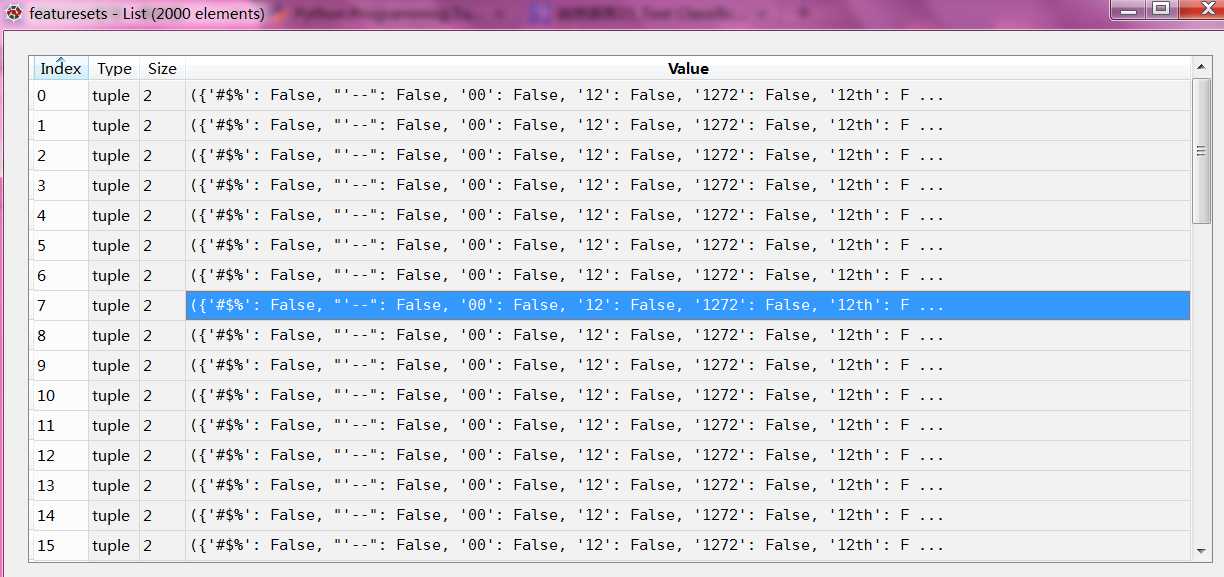自然语言27_Converting words to Features with NLTK
Posted
tags:
篇首语:本文由小常识网(cha138.com)小编为大家整理,主要介绍了自然语言27_Converting words to Features with NLTK相关的知识,希望对你有一定的参考价值。
https://www.pythonprogramming.net/words-as-features-nltk-tutorial/
Converting words to Features with NLTK
In this tutorial, we‘re going to be building off the previous video and compiling feature lists of words from positive reviews and words from the negative reviews to hopefully see trends in specific types of words in positive or negative reviews.
To start, our code:
import nltk
import random
from nltk.corpus import movie_reviews
documents = [(list(movie_reviews.words(fileid)), category)
for category in movie_reviews.categories()
for fileid in movie_reviews.fileids(category)]
random.shuffle(documents)
all_words = []
for w in movie_reviews.words():
all_words.append(w.lower())
all_words = nltk.FreqDist(all_words)
word_features = list(all_words.keys())[:3000]
Mostly the same as before, only with now a new variable, word_features, which contains the top 3,000 most common words. Next, we‘re going to build a quick function that will find these top 3,000 words in our positive and negative documents, marking their presence as either positive or negative:
def find_features(document):
words = set(document)
features = {}
for w in word_features:
features[w] = (w in words)
return features
Next, we can print one feature set like:
print((find_features(movie_reviews.words(‘neg/cv000_29416.txt‘))))
Then we can do this for all of our documents, saving the feature existence booleans and their respective positive or negative categories by doing:
featuresets = [(find_features(rev), category) for (rev, category) in documents]
Awesome, now that we have our features and labels, what is next? Typically the next step is to go ahead and train an algorithm, then test it. So, let‘s go ahead and do that, starting with the Naive Bayes classifier in the next tutorial!
# -*- coding: utf-8 -*-
"""
Created on Sun Dec 4 09:27:48 2016
@author: daxiong
"""
import nltk
import random
from nltk.corpus import movie_reviews
documents = [(list(movie_reviews.words(fileid)), category)
for category in movie_reviews.categories()
for fileid in movie_reviews.fileids(category)]
random.shuffle(documents)
all_words = []
for w in movie_reviews.words():
all_words.append(w.lower())
#dict_allWords是一个字典,存储所有文字的频率分布
dict_allWords = nltk.FreqDist(all_words)
#字典keys()列出所有单词,[:3000]表示列出前三千文字
word_features = list(dict_allWords.keys())[:3000]
‘‘‘
‘combating‘,
‘mouthing‘,
‘markings‘,
‘directon‘,
‘ppk‘,
‘vanishing‘,
‘victories‘,
‘huddleston‘,
...]
‘‘‘
def find_features(document):
words = set(document)
features = {}
for w in word_features:
features[w] = (w in words)
return features
words=movie_reviews.words(‘neg/cv000_29416.txt‘)
‘‘‘
Out[78]: [‘plot‘, ‘:‘, ‘two‘, ‘teen‘, ‘couples‘, ‘go‘, ‘to‘, ...]
type(words)
Out[65]: nltk.corpus.reader.util.StreamBackedCorpusView
‘‘‘
#去重,words1为集合形式
words1 = set(words)
‘‘‘
words1
{‘!‘,
‘"‘,
‘&‘,
"‘",
‘(‘,
‘)‘,.......
‘witch‘,
‘with‘,
‘world‘,
‘would‘,
‘wrapped‘,
‘write‘,
‘world‘,
‘would‘,
‘wrapped‘,
‘write‘,
‘years‘,
‘you‘,
‘your‘}
‘‘‘
features = {}
#victories单词不在words1,输出false
(‘victories‘ in words1)
‘‘‘
Out[73]: False
‘‘‘
features[‘victories‘] = (‘victories‘ in words1)
‘‘‘
features
Out[75]: {‘victories‘: False}
‘‘‘
print((find_features(movie_reviews.words(‘neg/cv000_29416.txt‘))))
‘‘‘
‘schwarz‘: False,
‘supervisors‘: False,
‘geyser‘: False,
‘site‘: False,
‘fevered‘: False,
‘acknowledged‘: False,
‘ronald‘: False,
‘wroth‘: False,
‘degredation‘: False,
...}
‘‘‘
featuresets = [(find_features(rev), category) for (rev, category) in documents]
featuresets 特征集合一共有2000个文件,每个文件是一个元组,元组包含字典(“glory”:False)和neg/pos分类

